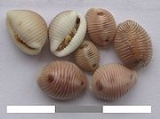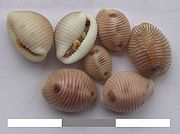
Trivia monacha
Encyclopedia
Trivia monacha, also known as the European cowrie or spotted cowrie, is a species
of small sea snail
, a marine
gastropod mollusc in the family
Triviidae
, the trivias.
The name Trivia means "common" and the word monacha means "solitary".
It is worth comparing this species with the similar species Trivia arctica
, the northern cowrie.
 The shell
The shell
of this species is glossy, convolute and lemon-shaped, with 20-30 transverse ridges. The dorsal part of the shell is a pinkish or reddish-brown with three characteristic darker spots in mature individuals, on spot anterior, the other posterior and one in the centre, all situated along a central line. Juvenile shells are all white or light-coloured. The apertural
side is white and flattened. The aperture is narrow and runs along the whole length of the shell. At the ends it turns to the left in the direction of the swollen body whorl
. The transverse ridges are strong and often bifurcate. The ones at the ends are almost U-shaped.
The shell length is up to a maximum of about 15 mm and its width about 8 mm.
The dark mantle
is covered by few papillae, usually tipped with pale yellow. The mantle is drawn out into a long siphon anteriorly, extending over the whole (or almost the whole) shell. The foot is orange or bright yellow.
The breeding season is late spring or summer. The larvae have a very dark stomach and intestine. More developed larvae in the veliger
stage have a two-lobed velum
that is slightly indented at sides. The larvae reach the adult form in about five to six months.
to the Orkney islands
north of Scotland
, but is more common in the south.
In Orkney and some parts of Scotland, the species are known as 'groatie buckies'.
and Diplosoma). Trivia monacha lacks small denticles on the admedian teeth of the radula. Furthermore, the rows of teeth in the two species are different.
. In fact they were considered to be two forms of the same species until 1925, when A. J. Peile published a paper in the Proceedings of the Malacological Society differentiating the two. They can be differentiated by the radula
, the shape of the penis
and their larva
l stages. In Trivia monacha the penis is filiform and cylindrical, while in Trivia arctica the penis is large and flat.
It is now known that the larva
e of the two species are readily distinguishable.
The Linnaean name Trivia europea, now lapsed, referred to the supposed single species. Linnaeus himself mentioned two kinds: Cypraea europea and Cypraea anglica, but these terms were intended as a geographical distinction and are not accepted as species names today.
Species
In biology, a species is one of the basic units of biological classification and a taxonomic rank. A species is often defined as a group of organisms capable of interbreeding and producing fertile offspring. While in many cases this definition is adequate, more precise or differing measures are...
of small sea snail
Sea snail
Sea snail is a common name for those snails that normally live in saltwater, marine gastropod molluscs....
, a marine
Marine (ocean)
Marine is an umbrella term. As an adjective it is usually applicable to things relating to the sea or ocean, such as marine biology, marine ecology and marine geology...
gastropod mollusc in the family
Family (biology)
In biological classification, family is* a taxonomic rank. Other well-known ranks are life, domain, kingdom, phylum, class, order, genus, and species, with family fitting between order and genus. As for the other well-known ranks, there is the option of an immediately lower rank, indicated by the...
Triviidae
Triviidae
Triviidae is a taxonomic family of small sea snails, marine gastropod molluscs in the clade Littorinimorpha.-Taxonomy:The following subfamilies were recognized in the taxonomy of Bouchet & Rocroi in 2005:*Eratoinae Gill, 1871**tribe Eratoini Gill, 1871...
, the trivias.
The name Trivia means "common" and the word monacha means "solitary".
It is worth comparing this species with the similar species Trivia arctica
Trivia arctica
Trivia arctica, the northern cowrie, is a species of small sea snail, a marine gastropod mollusc in the family Triviidae, the trivias.This is a similar species to Trivia monacha and often occurs in the same areas....
, the northern cowrie.
Shell description

Gastropod shell
The gastropod shell is a shell which is part of the body of a gastropod or snail, one kind of mollusc. The gastropod shell is an external skeleton or exoskeleton, which serves not only for muscle attachment, but also for protection from predators and from mechanical damage...
of this species is glossy, convolute and lemon-shaped, with 20-30 transverse ridges. The dorsal part of the shell is a pinkish or reddish-brown with three characteristic darker spots in mature individuals, on spot anterior, the other posterior and one in the centre, all situated along a central line. Juvenile shells are all white or light-coloured. The apertural
Aperture (mollusc)
The aperture is an opening in certain kinds of mollusc shells: it is the main opening of the shell, where part of the body of the animal emerges for locomotion, feeding, etc....
side is white and flattened. The aperture is narrow and runs along the whole length of the shell. At the ends it turns to the left in the direction of the swollen body whorl
Whorl (mollusc)
A whorl is a single, complete 360° revolution or turn in the spiral growth of a mollusc shell. A spiral configuration of the shell is found in of numerous gastropods, but it is also found in shelled cephalopods including Nautilus, Spirula and the large extinct subclass of cephalopods known as the...
. The transverse ridges are strong and often bifurcate. The ones at the ends are almost U-shaped.
The shell length is up to a maximum of about 15 mm and its width about 8 mm.
The dark mantle
Mantle (mollusc)
The mantle is a significant part of the anatomy of molluscs: it is the dorsal body wall which covers the visceral mass and usually protrudes in the form of flaps well beyond the visceral mass itself.In many, but by no means all, species of molluscs, the epidermis of the mantle secretes...
is covered by few papillae, usually tipped with pale yellow. The mantle is drawn out into a long siphon anteriorly, extending over the whole (or almost the whole) shell. The foot is orange or bright yellow.
The breeding season is late spring or summer. The larvae have a very dark stomach and intestine. More developed larvae in the veliger
Veliger
A veliger is the planktonic larva of many kinds of marine and freshwater gastropod molluscs, as well as most bivalve mollusks.- Description :...
stage have a two-lobed velum
Velum
Velum may refer to:* Superior medullary velum, part of the nervous system that stretches between parts of the brain* Veil , the veil-like membrane of immature mushrooms extending from the margin of the cap to the stem and torn by growth...
that is slightly indented at sides. The larvae reach the adult form in about five to six months.
Distribution
This species occurs from the Mediterranean SeaMediterranean Sea
The Mediterranean Sea is a sea connected to the Atlantic Ocean surrounded by the Mediterranean region and almost completely enclosed by land: on the north by Anatolia and Europe, on the south by North Africa, and on the east by the Levant...
to the Orkney islands
Orkney Islands
Orkney also known as the Orkney Islands , is an archipelago in northern Scotland, situated north of the coast of Caithness...
north of Scotland
Scotland
Scotland is a country that is part of the United Kingdom. Occupying the northern third of the island of Great Britain, it shares a border with England to the south and is bounded by the North Sea to the east, the Atlantic Ocean to the north and west, and the North Channel and Irish Sea to the...
, but is more common in the south.
In Orkney and some parts of Scotland, the species are known as 'groatie buckies'.
Habitat
This species usually lives on rocky shores or under stones below low tide, in other words is sublittoral, but the empty shells of this species are often washed up onto beaches. It is usually found together with compound ascidians (Botrylus, BotrylloidesBotrylloides
The "Chain Sea Squirts or Chain Tunicates" of the genus Botrylloides:Morphologically similar to Botryllus schlosseri and similarly widespread, Botrylloides is distinguished by having linearly-arranged, parallel "chains" of zooids as opposed to zooids like white or yellow stripes emanating from a...
and Diplosoma). Trivia monacha lacks small denticles on the admedian teeth of the radula. Furthermore, the rows of teeth in the two species are different.
Similar species
Trivia monacha is sometimes confused with Trivia arcticaTrivia arctica
Trivia arctica, the northern cowrie, is a species of small sea snail, a marine gastropod mollusc in the family Triviidae, the trivias.This is a similar species to Trivia monacha and often occurs in the same areas....
. In fact they were considered to be two forms of the same species until 1925, when A. J. Peile published a paper in the Proceedings of the Malacological Society differentiating the two. They can be differentiated by the radula
Radula
The radula is an anatomical structure that is used by molluscs for feeding, sometimes compared rather inaccurately to a tongue. It is a minutely toothed, chitinous ribbon, which is typically used for scraping or cutting food before the food enters the esophagus...
, the shape of the penis
Penis
The penis is a biological feature of male animals including both vertebrates and invertebrates...
and their larva
Larva
A larva is a distinct juvenile form many animals undergo before metamorphosis into adults. Animals with indirect development such as insects, amphibians, or cnidarians typically have a larval phase of their life cycle...
l stages. In Trivia monacha the penis is filiform and cylindrical, while in Trivia arctica the penis is large and flat.
It is now known that the larva
Larva
A larva is a distinct juvenile form many animals undergo before metamorphosis into adults. Animals with indirect development such as insects, amphibians, or cnidarians typically have a larval phase of their life cycle...
e of the two species are readily distinguishable.
The Linnaean name Trivia europea, now lapsed, referred to the supposed single species. Linnaeus himself mentioned two kinds: Cypraea europea and Cypraea anglica, but these terms were intended as a geographical distinction and are not accepted as species names today.
External links
- Arkive.org: Trivia monacha
- Marlin: Trivia monacha
- Sabella.mba.ac.uk : The_British_species of Trivia : T. arctica_and T. monacha
- P.J. Wayward & J.S. Ryland, Handbook of the Marine Fauna of North-West Europe, Oxford University Press, Oxford, 1996, ISBN 019 854055 8

